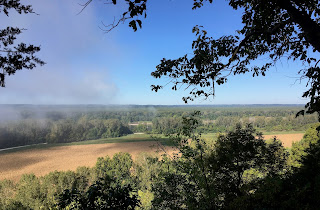Birders often remember their excursions based on a certain species; one that was new to them, one that they seldom observe, one that was rare or "out of place" or one that was especially abundant or conspicuous on that day. This morning, at Forum Nature Area in Columbia, my "bird of the day" was a Philadelphia vireo.
These warbler-like vireos are uncommon migrants through Missouri. After breeding in mixed woodlands across Southern Canada, from the Rockies eastward, Philadelphia vireos head for the Tropics to spend the northern winter. In all seasons, they feed primarily on insects, usually gleaning them from the leaves of trees and shrubs.
At most, I seem to encounter one of these migrants each year, usually in the fall. This morning's visitor, hunting in a lakeside willow with a mixed flock of chickadees and titmice, was, I presume, my annual sighting. I wish him safe travels!







